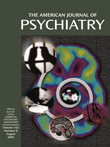To the Editor: Schneiderian first-rank symptoms of schizophrenia may reflect defective “internal monitoring” of intentions and actions by aberrant sensory systems. Previous positron emission tomography (PET) studies have implicated right parietal hyperactivation (Brodmann’s area 40)
(1,
2). The latter may arise from a failure of “forward-modeling” so that endogenous sensory data (consequent upon voluntary motor activity) are felt to originate outside the subject
(3,
4). Failure to predict the sensory consequences of actions might be associated with failure to attenuate sensory-related neural activity; hence, the parietal hyperactivation observed with PET
(1–
4).
Using an event-related functional magnetic resonance imaging (fMRI) paradigm, permitting subjects to choose the timing of their own movements, we examined the hypothesis that patients experiencing first-rank symptoms exhibit hyperactivation of right Brodmann’s area 40 (compared to patients without first-rank symptoms). Also, consistent with the “forward-modeling” hypothesis, we predicted that aberrant right Brodmann’s area 40 activation would follow that of the primary motor cortex (Brodmann’s area 4).
Functional imaging data were acquired on a 1.5-T system in 13 right-handed, male schizophrenia (DSM-IV) patients, each studied twice, with written informed consent and ethics committee approval. Patients with first-rank symptoms (N=7) (age: mean=36 years, SD=11; illness duration: mean=15 years, SD=11; premorbid IQ: mean=102.1, SD=9.7; chlorpromazine equivalents: mean=507.1 mg/day, SD=255.7; extrapyramidal symptom score: mean=5.6, SD=10.5) were comparable with those without first-rank symptoms (N=6) (independent-sample t test, df=11, p>0.05 on all measures). The patients performed spontaneous, freely timed movements using their right index finger in an event-related fMRI paradigm
(5). Images were analyzed by using a random-effects model in statistical parametric mapping. The validity of the parametric results was examined with nonparametric permutation tests. We examined the response latency in left Brodmann’s area 4 and right Brodmann’s area 40 by using time to half-maximum blood-oxygen-level-dependent response as a measure of latency
(5).
Statistical parametric mapping analysis revealed that patients with first-rank symptoms had significant hyperactivation of right Brodmann’s area 40 (Talairach coordinates=57, –29, 36) (t=4.7, df=24, uncorrected p<0.0001, two-sample t test; family-wise error corrected: p<0.02 [volume-of-interest right Brodmann’s area 40]) relative to patients without first-rank symptoms. A two-group test (5,000 permutations) in statistical parametric mapping supported the validity of this finding (t=4.7, df=24, p=0.0002). Mean time to half-maximum response was 177 msec later in right Brodmann’s area 40 than left Brodmann’s area 4.
To our knowledge, this is the first fMRI study replicating previous PET findings with regard to first-rank symptoms
(1,
2). Of importance, the observations derive from an ecologically valid spontaneous movement paradigm (approximating “truly” spontaneous behavior, as might occur outside the scanner
[5]). The observation that parietal cortex activation occurs later than that of motor cortex supports the “forward-modeling” hypothesis.

